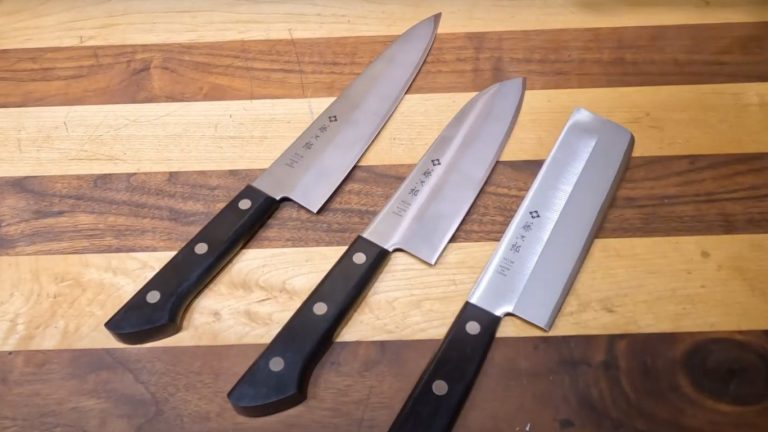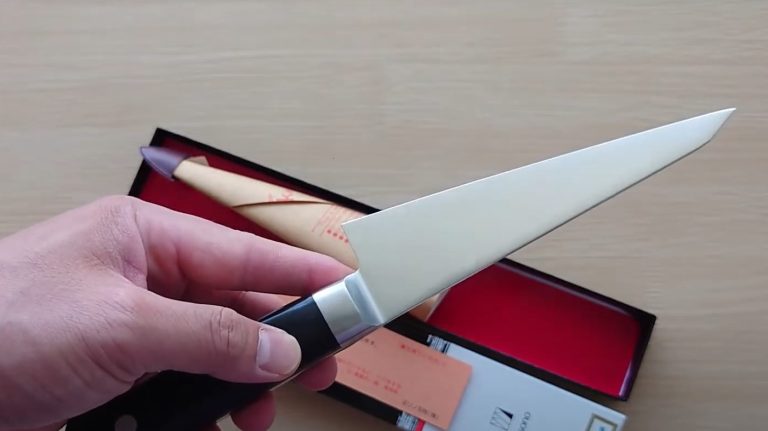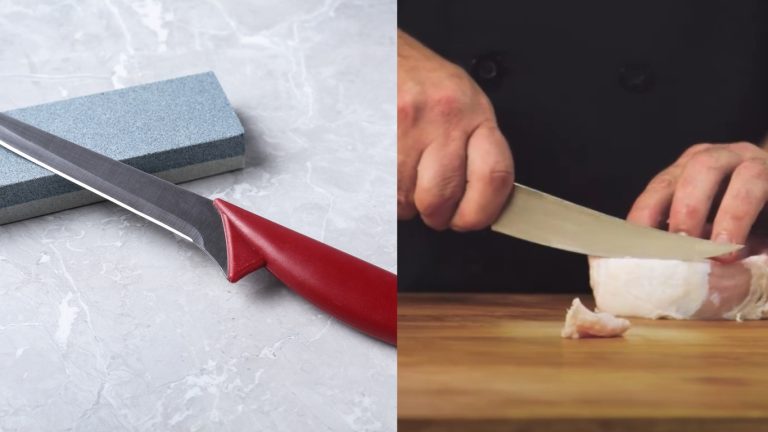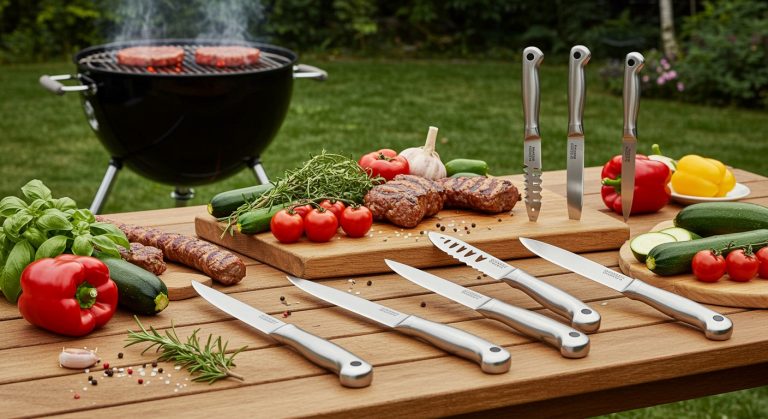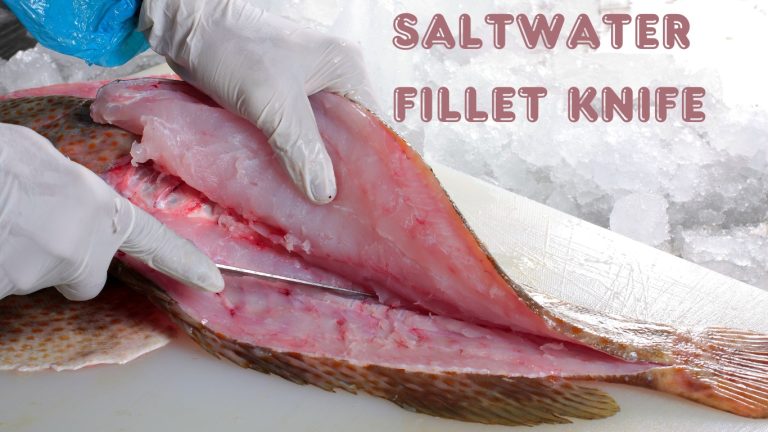Bunka vs Gyuto: Which Knife Rules Your Kitchen?
When choosing between a Bunka and a Gyuto, you’ll notice the Bunka’s reverse tanto K-tip and flat edge excel at precision cuts for veggies, while its compact size offers great control.
The Gyuto, with its curved belly and longer blade, shines in slicing hefty meats and rocking through herbs.
You can’t go wrong with either, but their unique designs cater to different tasks. Stick around to uncover deeper insights into their strengths.
Key Takeaways
- Bunka has a reverse tanto K-tip for precision, while Gyuto’s curved edge suits rock-chopping.
- Bunka’s shorter blade (120-240mm) offers maneuverability; Gyuto’s longer blade (180-300mm) excels in slicing.
- Bunka’s flat edge is ideal for clean vegetable chops; Gyuto’s belly aids herb mincing.
- Gyuto’s length handles large meats like roasts; Bunka suits smaller cuts like poultry.
- Bunka’s wide profile provides knuckle clearance; Gyuto’s narrower design enhances slicing efficiency.
Blade Design and Profile
When you explore into the blade design showdown between Bunka and Gyuto knives, you’ll notice striking differences right away.
Dive into the blade battle of Bunka vs. Gyuto knives and uncover the bold design differences that set them apart instantly.
The Bunka boasts a distinctive ‘reverse tanto’ K-tip, with a straight cutting edge and a wide, flat belly.
Its sloping spine and angular, lower tip offer precision for intricate tasks.
Plus, its wider profile gives you great knuckle clearance.
On the flip side, the Gyuto sports a tapered shape like a Western chef’s knife, with a curved edge and a centrally aligned, pointed tip.
It’s generally narrower and often longer, ranging from 180 to over 300mm, compared to the Bunka’s typical 120-240mm.
The Gyuto’s spine slopes downward, crafting a sleek, versatile look that’s instantly recognizable in any kitchen.
This longer blade often enhances the Gyuto’s sweeping blade profile for more efficient slicing tasks.
Additionally, the Gyuto’s design supports push/pull cuts for achieving clean and precise slices in various culinary applications.
Cutting Performance and Techniques
Let’s shift focus from blade shapes to how Bunka and Gyuto knives perform in action with their cutting techniques.
You’re in for a thrilling experience as you wield these Japanese blades, each with unique strengths that ignite your passion for precision and power.
Feel the rush with these cutting dynamics:
- Bunka’s Precision: That K-tip lets you carve intricate designs, making every detailed cut a masterpiece.
- Gyuto’s Versatility: Rock-chop with its curved belly, slicing through herbs with effortless rhythm.
- Bunka’s Chopping: Its flatter edge slams down for clean, satisfying chops on veggies.
- Gyuto’s Slicing: Glide through larger items with its longer blade, feeling unstoppable.
Additionally, the Bunka’s compact size makes it incredibly maneuverable in tight spaces, perfect for smaller kitchens or detailed tasks.
In contrast, the Gyuto’s design facilitates rock chopping for efficient slicing of meats and vegetables.
Primary Uses in the Kitchen
When you’re prepping veggies in the kitchen, you’ll notice the Bunka’s flat edge excels at precise cuts and detailed work, while the Gyuto offers versatility for chopping larger batches. This versatility is enhanced by the Gyuto’s design, which often incorporates high-carbon stainless steel for superior edge retention.
For meat cutting, you’ve got the Gyuto’s longer blade tackling big cuts of beef or poultry with ease, whereas the Bunka shines with smaller portions and light butchering tasks. Additionally, the Bunka’s design makes it a fantastic all-purpose knife for handling fish and other delicate proteins with control.
If precision is your goal, you’ll appreciate the Bunka’s pointed K-tip for intricate scoring or brunoise cuts, giving you an edge over the Gyuto’s broader focus.
Vegetable Prep Strengths
As you begin on vegetable prep in the kitchen, you’ll find that both the Bunka and Gyuto knives shine with distinct strengths tailored to different tasks.
The Bunka’s flat edge and K-tip offer precision for fine dicing and intricate cuts, while its shorter blade thrives on smaller boards.
The Gyuto’s curved belly excels at rocking motions for mincing herbs, and its longer blade tackles larger veggies with ease. Both knives benefit from edge retention that enhances their performance during prolonged chopping sessions.
Feel the magic of these blades with:
- Bunka’s sharp tip piercing delicate vegetables for stunning detail.
- Gyuto’s rhythmic rock transforming onions into perfect mince.
- Bunka’s wide blade scooping chopped bits effortlessly.
- Gyuto’s pointed precision crafting thin, even slices.
Additionally, the Bunka’s design ensures full board contact for cleaner, more precise slices during vegetable prep.
Meat Cutting Differences
Precision reigns supreme when you’re tackling meat in the kitchen, and both the Bunka and Gyuto knives bring unique strengths to the cutting board.
The Gyuto, dubbed the “cow sword,” shines with its longer blade, perfect for slicing through hefty roasts or steaks.
You’ll love its versatility for portioning meat or trimming fat with smooth, rocking motions. However, as a double-bevel knife, it provides the advantages of easy maintenance compared to single bevel options.
On the flip side, the Bunka’s shorter blade and k-tip design make it a champ for smaller cuts.
You can effortlessly slice poultry or fish, using push or pull cuts to handle softer meats.
Its pointed tip also helps with detailed trimming under fat or sinew.
As a double-beveled knife, the Gyuto offers easier maintenance and durability for frequent meat cutting tasks (double-beveled design).
Precision Task Advantages
How do you achieve flawless precision in the kitchen? With the right knife, you can transform mundane tasks into art. SG2 steel is often utilized in high-performance knives to enhance durability and edge retention for such precise work.
The Bunka, with its angular K-tip and compact size (5.5-7 inches), offers unmatched control for intricate cuts like brunoise or garnishes.
Its flatter blade excels in push-cutting, while the Gyuto’s pointed tip and slimmer profile shine in fine dicing and fish filleting, despite its longer reach (7-12 inches). Additionally, the Gyuto’s design, inspired by western chef’s knives, ensures superior edge retention for consistent performance over time.
Feel the thrill of precision with these tasks:
- Scoring bread dough – Bunka’s tip creates perfect patterns.
- Julienning veggies – Bunka’s agility inspires confidence.
- Mincing herbs – Gyuto’s balance guarantees finesse.
- Trimming proteins – Bunka’s control feels empowering.
Historical Background and Evolution
Hey, let’s explore the fascinating origins of the Gyuto and Bunka knives as they mark key shifts in Japanese culinary history.
You’ll find the Gyuto, born during the Meiji Era (1868-1912), emerging as a “cow sword” to tackle the rise of beef in Japanese diets, heavily inspired by Western chef’s knives.
Meanwhile, the Bunka, with its name meaning “culture,” popped up in the post-war era, embodying modernity as an all-purpose blade for diverse home cooking. This evolution reflects how Japanese knives adapted over centuries to meet changing culinary needs adapted over centuries.
Bunka’s Post-War Emergence
After the turmoil of World War II, Japan’s culinary world transformed, and that’s when the Bunka knife emerged as a symbol of this shift.
You’re stepping into a new era where “Bunka,” meaning “culture,” blends tradition with Western influence, crafting a versatile tool for your evolving kitchen.
Imagine wielding this modern marvel, designed for meat, fish, and veggies with a clever K-tip for precision.
This knife, born from the Meiji era’s cultural evolution, represents a break from rigid Edo period traditions Meiji era’s evolution.
Feel the Bunka’s impact with these emotional ties:
- Innovation – You’re embracing post-war progress.
- Versatility – One knife conquers all tasks.
- Connection – It mirrors your diverse, modern palate.
- Efficiency – Streamline prep with its hybrid design.
Gyuto’s Meiji Era Roots
Step into the transformative Meiji Era (1868-1912), where Japan shed isolation and embraced Western influence. You’d see Emperor Meiji championing progress, lifting the centuries-old ban on red meat in 1872, urging beef consumption for national strength.
Amid this shift, the Gyuto, or “cow blade,” emerged as a meat-cutting marvel, blending Western chef knife designs with Japanese finesse. Imagine skilled samurai swordsmiths, post-Haitōrei Edict, forging these lighter, sharper blades using ancient techniques and hard Hagane steel.
You’d notice Gyuto’s double-bevel edge and multi-purpose prowess replacing traditional knives in modern kitchens. Originally known as kengata, the Gyuto was adapted by Japanese blacksmiths to suit Western cuisine needs Western cuisine adaptation.
Here’s a quick peek at Gyuto’s roots:
| Aspect | Meiji Influence |
|---|---|
| Era | 1868-1912 |
| Meat Ban Lifted | 1872 |
| Blade Name | Gyuto (“Cow Blade”) |
| Craftsmanship | Samurai Swordsmiths |
Versatility Across Tasks
Ever wondered how a single knife can tackle a wide array of kitchen tasks with ease?
Let’s delve into the Bunka’s versatility, a true all-rounder in your kitchen.
You’ll find it effortlessly handles meat, fish, veggies, and herbs, mastering everything from chopping to intricate cuts with its angular K-tip.
Feel the magic of the Bunka with these emotional highlights:
- Precision Joy – Craft delicate garnishes with its pinpoint control.
- Vegetable Victory – Slice through onions and chives with satisfying ease.
- Meat Mastery – Trim fat and fillet fish, feeling like a pro. For optimal results, employ long, smooth strokes when handling meat with precision.
- Herb Harmony – Mince garlic and herbs, infusing flavors flawlessly.
With its flat profile, you’re set for push-cutting and tap-chopping, making every task a breeze!
Its wider blade design, influenced by traditional Nakiri and Usuba knives, excels in horizontal cutting motions.
Ideal User Scenarios
Dive into the world of kitchen knives with a clear understanding of who best suits the Bunka and Gyuto!
If you’re a cook craving precision, the Bunka’s your match.
You’ll excel at intricate vegetable prep, scoring, and decorative cuts with its sharp, pointed tip.
It’s perfect if you prioritize detail over volume, slicing smaller proteins or mincing herbs with finesse.
The Bunka’s versatility also shines in tasks like light butchering, thanks to its angled tip design.
On the flip side, if you’re accustomed to Western chef’s knives, grab a Gyuto.
You’ll love its familiar shape and rocking motion for efficient cutting.
It’s ideal if you tackle diverse ingredients or high-volume tasks, handling large meats and produce effortlessly.
Whether you’re a home cook or pro, the Gyuto adapts to most kitchen challenges with ease. Additionally, for light butchering tasks, the Gyuto’s straight blade provides the same predictable cutting action as straight boning knives.
Size and Handling Differences
Imagine wielding a blade that feels like an extension of your hand—size and handling make all the difference between the Bunka and Gyuto.
You’ll notice the Bunka’s compact length, often 165mm to 200mm, and lighter weight, around 5-7 ounces, making it agile for precise tasks.
The Gyuto, ranging from 180mm to 300mm, feels heftier, especially at longer sizes, sometimes causing fatigue.
Feel the distinction with these emotional contrasts:
- Bunka’s lightness: You’re dancing through cuts with effortless grace.
- Bunka’s balance: You control every slice with pinpoint accuracy.
- Gyuto’s power: You’re commanding larger tasks with robust strength.
- Gyuto’s weight: You’ll sense the burden during extended sessions.
Additionally, the Bunka’s shorter blade and flat profile make it ideal for tap-chopping and push-cutting techniques flat profile ideal.
Hoshanho knives incorporate ergonomic handles to further improve the Bunka’s balance and comfort during extended use.
Edge Maintenance and Durability
When maintaining your Bunka or Gyuto, you’ll notice that sharpening ease varies with the steel type—harder steels like Aogami Super demand more effort on the whetstone, while softer ones like Shirogami feel smoother to refine.
Blade longevity also hinges on how often you hone and the steel’s properties, with high-carbon options often outlasting stainless if you keep rust at bay. This superior performance is often due to the edge retention capabilities of carbon steel, which help maintain a sharp edge over time.
Consider these factors as you care for your knife, ensuring its edge stays razor-sharp for countless meals. Different steel types offer unique strengths and weaknesses, so choosing the right one depends on your maintenance habits and cooking needs.
Sharpening Ease Comparison
Explore into the art of sharpening, and you’ll quickly notice the subtle differences between maintaining a Bunka and a Gyuto. When you sharpen a Gyuto, adjust your motion along its curved belly, ensuring contact from heel to tip.
For a Bunka, the flatter edge feels smoother to hone, but that K-tip demands precision to avoid damage. Both thrive on whetstones, with angles of 15-20 degrees, yet each stirs unique emotions.
This traditional whetstone method, rooted in centuries of Japanese craftsmanship, requires soaking stones to enhance their abrasive properties.
- Gyuto’s curve: Feel the challenge as you roll the blade, mastering its grace.
- Bunka’s edge: Savor the ease of its straight profile, a calming rhythm.
- K-tip caution: Guard its delicate point, a test of care.
- Sharp reward: Revel in the razor edge, your skill triumphant.
Blade Longevity Factors
Precision guides the journey of blade longevity for both Bunka and Gyuto knives, where edge maintenance and durability hinge on critical factors.
You’ll find that steel choice—high-carbon for razor-sharp edges or stainless for rust resistance—shapes how long your blade stays keen.
Harder steels, often 60-64 HRC in Japanese knives, retain sharpness but risk chipping if you’re not careful with hard cuts.
Pay attention to blade geometry; thinner edges slice beautifully but wear faster.
Your Bunka’s delicate K-tip demands extra caution to avoid damage, while the Gyuto’s sturdier tip fares better.
Maintain your edge with regular honing and timely sharpening on whetstones.
Wash and dry high-carbon blades immediately to dodge rust, ensuring your knife’s lasting performance.
Additionally, the choice of materials like VG10 or Aogami in both knives significantly impacts their edge retention.
Precision and Tip Functionality
How do you choose between a Bunka and a Gyuto when precision matters most?
Picture yourself crafting intricate garnishes or mincing garlic with surgical accuracy.
The Bunka’s sharp K-tip shines in detailed tasks, offering unmatched control with its shorter blade.
Meanwhile, the Gyuto’s pointed tip excels in versatile precision, perfect for trimming fat or maneuvering tight spaces on larger cuts.
The Gyuto’s design, with an edge angle of 15-18 degrees, ensures superior control for intricate slicing and detailed work.
Feel the difference with these emotional triggers:
- Bunka’s Mastery: Revel in the thrill of flawless, decorative cuts.
- Gyuto’s Versatility: Savor the confidence of tackling any precise task.
- Bunka’s Control: Cherish the power of pinpoint accuracy.
- Gyuto’s Reach: Embrace the ease of long, smooth slicing.
Choosing the Right Knife for Your Needs
Imagine standing in your kitchen, ready to tackle any dish, but which knife should you grab—the Bunka or the Gyuto?
If you’re craving versatility with a stylish edge, pick the Bunka.
Its shorter, lighter frame (around 165mm) excels at precision tasks like mincing herbs or slicing small veggies with clean, vertical chops.
Additionally, the Bunka’s design, featuring a pointed tip, enhances dexterity for both large and precise cuts.
On the other hand, if you’re slicing hefty roasts or larger cuts of meat, grab the Gyuto.
With its longer blade (often 210mm), slight curve, and rock-chopping prowess, it handles big ingredients effortlessly.
Consider your cooking style—detailed work calls for Bunka’s control, while broader tasks suit Gyuto’s reach.
Frequently Asked Questions
What Materials Are Used for Bunka and Gyuto Handles?
Hey, let’s delve into the materials used for knife handles!
You’ll find traditional Wa-handles crafted from lightweight Ho wood, elegant ebony, or striking rosewood, often paired with buffalo horn ferrules.
For a modern twist, check out durable synthetics like Pakkawood, Micarta, or G10, offering great grip and water resistance.
Whether you prefer the classic warmth of wood or tough composites, there’s a handle that’ll feel just right in your hand!
How Do Bunka and Gyuto Prices Compare?
Hey, you’re curious about how knife prices stack up, right?
Delve into this world, and you’ll find a wild range—from budget-friendly blades under $100 to artisan masterpieces soaring past $1,000.
Steel quality, craftsmanship, and fancy handles drive costs up.
You’ll notice overlaps; some knives outprice others based on unique traits.
Keep an eye on brand reputation too—it’s a game-changer in what you’ll shell out!
Are Bunka and Gyuto Suitable for Professional Kitchens?
Hey, you’re wondering if certain Japanese knives are suitable for professional kitchens? Absolutely, they’re game-changers!
You’ll find their versatility perfect for slicing meat, fish, and veggies with precision.
Their lightweight design and sharp edges boost your efficiency during long shifts.
Whether you’re chopping, dicing, or trimming, they adapt to your style.
With excellent edge retention, you won’t need constant sharpening.
Trust me, they’re essential tools for any pro chef!
Which Knife Is Better for Left-Handed Users?
Hey, if you’re a left-handed cook, picking the right knife is key to comfort and precision!
Look for double-beveled edges that work for both hands and symmetrical handles like octagonal or oval shapes to avoid bias.
Don’t settle for discomfort—check for true 50/50 grinds.
If you’re eyeing asymmetrical designs or D-shaped handles, make sure you grab a dedicated left-handed version for the best grip and control!
Do Bunka and Gyuto Require Special Storage?
Ever wondered if your prized kitchen blades need a royal treatment for storage? Well, you’ve gotta give them the care they deserve!
Store your knives on wooden magnetic strips or in snug knife blocks to prevent scratches.
Use sayas or guards for drawer storage, and always dry them thoroughly to dodge rust.
Don’t skimp on oiling high-carbon steel—keep moisture at bay and let your blades shine!
Bold or Balanced? Your Perfect Kitchen Partner Awaits
Hey there, when choosing between a bunka and a gyuto, trust your instincts to guide you like a compass through a culinary storm.
If you crave versatility and precision, grab the gyuto for its sleek, all-purpose prowess. Prefer bold, unique cuts?
The bunka’s striking tip awaits. Match the blade to your kitchen dance size, handling, and tasks matter. Pick wisely, and let your knife become an extension of your creative spirit.



